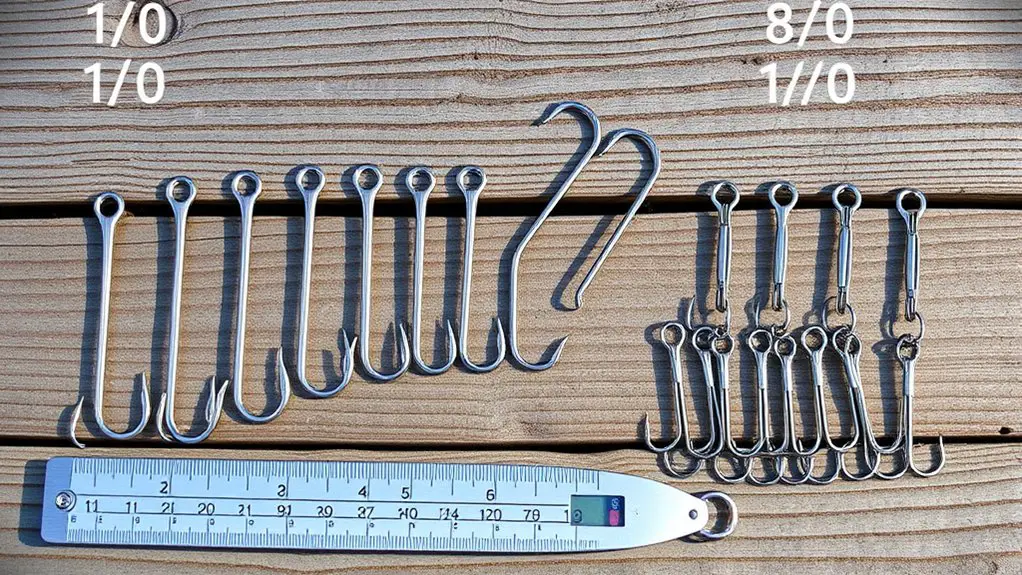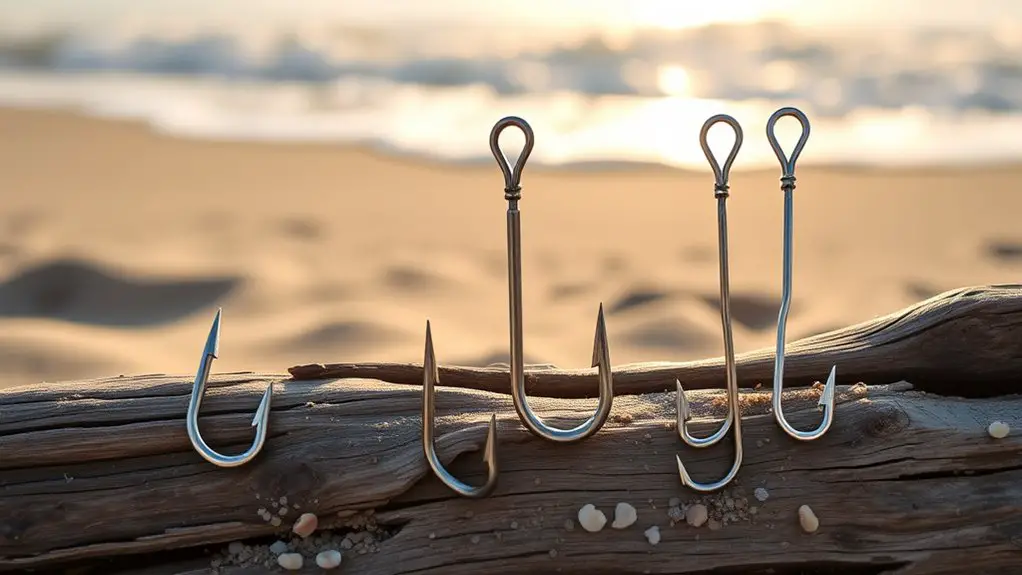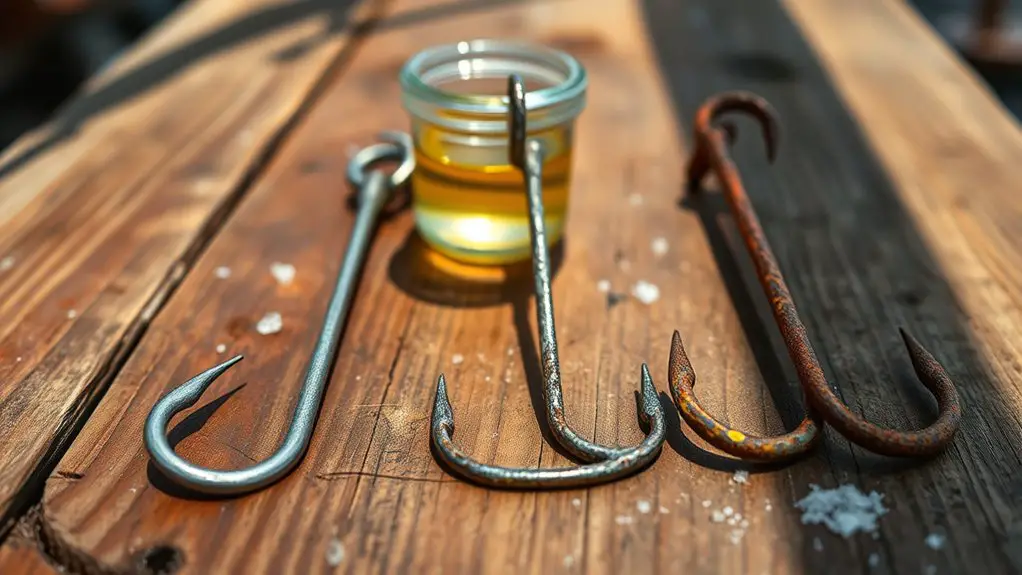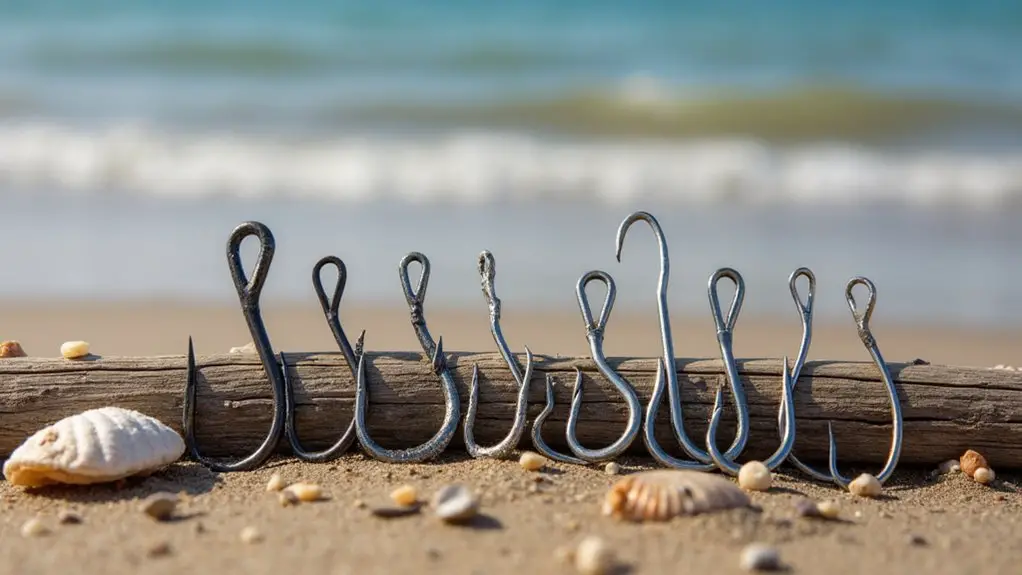For successful surfcasting, you’ll need to match your hooks to both target species and conditions. Circle hooks excel for catch-and-release with an impressive 85% jaw hook rate, while J-hooks work better with active lures and quick-striking fish. Size matters—use #6 to #1 for smaller species, 4/0 to 6/0 for bass and snapper, and 8/0+ for sharks. Don’t forget material considerations; stainless steel withstands saltwater best. Your perfect surf fishing setup awaits in the details below.
Surf Fishing Highlights
- Match hook size to target fish species: small (#6-#1) for whiting, medium (1/0-2/0) for redfish, and large (4/0+) for sharks.
- Circle hooks reduce mortality rates by 66% and improve hook-up rates, making them ideal for catch-and-release surfcasting.
- Consider environmental factors like beach structure, water clarity, and tidal patterns when selecting hook style and size.
- Choose corrosion-resistant materials like stainless steel or vanadium for saltwater durability and longevity.
- Adapt hook style to bait presentation: J-hooks for artificial lures, circle hooks for live bait, and weedless options for rocky bottoms.
Understanding Basic Hook Types for the Surf
Success in surfcasting begins with hook selection, the critical connection between you and your prized catch.
Your hook is the handshake between angler and ocean—choose wisely to transform potential into catch.
When you’re battling the elements at the shoreline, your hook choice can make or break your day.
J-hooks, the versatile classics, excel with everything from cut bait to artificial lures.
Treble hooks—those three-pronged wonders—shine on crankbaits and topwater plugs.
For toothy critters like bluefish, you’ll want long shank hooks (your line will thank you!).
When targeting bulldogs like grouper, short shank hooks provide that bend-resistant strength you need.
Circle hooks significantly reduce gut hooking![]() while maintaining a high hook-up ratio, making them ideal for catch and release fishing.
while maintaining a high hook-up ratio, making them ideal for catch and release fishing.
For novice surf fishermen, circle hooks![]() are highly recommended as they don’t require setting and provide higher hook-up rates.
are highly recommended as they don’t require setting and provide higher hook-up rates.
Don’t overlook specialty Kale hooks if you’re actively fishing live bait for game species.
For effective hook selection, remember that hook sizes are inversely numbered, with smaller numbers![]() indicating larger hooks in standard sizes, switching to “/0” notation for the biggest options.
indicating larger hooks in standard sizes, switching to “/0” notation for the biggest options.
The Essential Role of Circle Hooks in Surfcasting
Moving beyond traditional hook designs, circle hooks have revolutionized the surfcasting game in recent years—and for good reason.
They’ll double your hook-up rates while greatly reducing fish mortality—a win-win for anglers and conservation.
You’ll notice about 85% of strikes with circle hooks land perfectly in the jaw corner, virtually eliminating those heartbreaking gut hooks.
Unlike J-hooks (which cause bleeding 21 times more often!), they’re designed to set themselves as fish move laterally after taking bait.
For catch-and-release surfcasting, they’re simply unmatched, cutting mortality rates by two-thirds in prized species like stripers and reds.
Recent research challenges this view, suggesting circle hooks may not actually reduce discard mortality![]() in Atlantic Striped Bass as previously assumed.
in Atlantic Striped Bass as previously assumed.
Studies on billfish fisheries have consistently reported twice as many![]() hook-ups when using circle hooks compared to traditional J hooks.
hook-ups when using circle hooks compared to traditional J hooks.
J-Hooks: When and Why They Excel in Surf Conditions
While circle hooks dominate catch-and-release discussions, traditional J-hooks still hold three distinct advantages in specific surf fishing scenarios.
Their wide gape design excels when you’re working active lures or smaller baits for species like surf perch and croaker. You’ll appreciate the versatility when rigging plastic grubs, sandworms, or dropshot presentations. When trolling for gamefish like tuna, J hooks lie flat![]() in the bait, maintaining better bait integrity than circle hooks that require bridging. They require a solid hook-set
in the bait, maintaining better bait integrity than circle hooks that require bridging. They require a solid hook-set![]() for proper fish penetration, which means staying vigilant and maintaining contact with your line at all times.
for proper fish penetration, which means staying vigilant and maintaining contact with your line at all times.
J-hooks shine when you need to make quick, deliberate hook sets with a rod sweep. They’re your go-to when targeting aggressive shoreline feeders or when fishing techniques demand your active participation. Brands like Owner and Gamakatsu![]() offer premium chemically-sharpened options that significantly improve hook-up rates compared to cheaper alternatives.
offer premium chemically-sharpened options that significantly improve hook-up rates compared to cheaper alternatives.
J-hooks deliver when immediate action counts—perfect for the alert angler facing aggressive surf predators.
Just remember, what you gain in versatility and strike conversion, you might sacrifice in secure hookups during extended battles.
Matching Hook Sizes to Target Species

Beyond hook type, selecting the proper hook size dramatically influences your surfcasting success rate. You’ll find that the right hook balances between being large enough to secure your fish, yet small enough not to spook it away. With Owner’s Hook’s extensive catalog![]() of 1121 different hooks, you have options perfectly tailored for any surfcasting scenario. Remember that circle hooks
of 1121 different hooks, you have options perfectly tailored for any surfcasting scenario. Remember that circle hooks![]() provide superior hook-up rates while minimizing the risk of gut-hooking your catch.
provide superior hook-up rates while minimizing the risk of gut-hooking your catch.
| Fish Size | Species Examples | Recommended Hook Sizes |
|---|---|---|
| Small | Whiting, Croaker | #6 to #1 |
| Medium | Redfish, Pompano | 1/0 to 2/0 |
| Large | Snapper, Bass | 4/0 to 6/0 |
| Monster | Sharks, Tarpon | 8/0 to 12/0 |
Hook Materials: Selecting for Saltwater Durability
Since the harsh saltwater environment can quickly destroy inferior hooks, choosing the right material becomes essential for your surfcasting success.
Stainless steel hooks are your most reliable allies, resisting the ocean’s corrosive assault while maintaining integrity season after season.
High carbon steel offers impressive strength and sharpness (perfect for trophy fish!), but you’ll need to rinse thoroughly after each use.
Vanadium steel hooks provide an excellent alternative as they are lightweight and stronger![]() than stainless steel options while allowing for better penetration.
than stainless steel options while allowing for better penetration.
Those protective coatings aren’t just for show—they’re your hook’s armor against salt.
Nickel hooks represent a solid choice for surfcasting as they resist corrosion effectively![]() while featuring a smooth finish ideal for saltwater environments.
while featuring a smooth finish ideal for saltwater environments.
Bronze hooks might save you money upfront, but they’ll surrender to corrosion faster than their premium counterparts.
Regular inspection of your hooks for signs of wear or damage is crucial, as proper maintenance![]() extends their lifespan and ensures optimal performance.
extends their lifespan and ensures optimal performance.
Specialized Hooks for Live Bait Presentations
Three essential hook designs dominate the live bait surfcasting scene: circle hooks, J-hooks, and specialized Siwash hooks.
Circle hooks excel at corner-mouth hooksets, dramatically reducing gut-hooking and improving catch-and-release survival—perfect when you’re letting fish take the bait naturally. Circle hooks are also the official hook![]() for billfish tournaments due to their conservation benefits.
for billfish tournaments due to their conservation benefits.
For conservation-minded anglers, circle hooks deliver the perfect compromise: deadly efficiency with minimal harm to released fish.
Match your hook’s wire gauge to your bait size; heavier duty hooks for pilchards or goggle eyes, lighter wire for delicate shiners that need freedom to swim enticingly. Your hook size should complement both bait and target species. For optimal live bait presentation, short shank hooks![]() allow natural swimming motion and keep your bait lively longer.
allow natural swimming motion and keep your bait lively longer.
Kale hooks are particularly effective when targeting larger game fish![]() like tarpon, redfish, and snook in surf fishing scenarios.
like tarpon, redfish, and snook in surf fishing scenarios.
For quick-striking predators, J-hooks shine, while Siwash hooks—with their long points and round bends—hold fast in powerful fish mouths when the surf’s pounding.
How Fish Behavior Influences Hook Selection

When you’re standing on the shore reading the surf, the fish beneath those waves are simultaneously reading your presentation. Understanding their behavior is your secret weapon for hook selection success.
Notice how species feed differently? Aggressive strikers like kahawai need J-hooks with open gapes that penetrate quickly, while nibbling feeders require smaller, less intimidating options.
Your hook-setting technique matters too—fast jerks for J-hooks, steady pressure for circles. Even mouth anatomy dictates choice; small-mouthed species can’t handle those 5/0 monsters that trophy predators require. Remember that exposing the barb![]() is crucial for effective hookups, especially with tough baits like squid. Sharks are especially predictable, as they typically hit baits firmly
is crucial for effective hookups, especially with tough baits like squid. Sharks are especially predictable, as they typically hit baits firmly![]() and often hook themselves, making them ideal targets for circle hooks.
and often hook themselves, making them ideal targets for circle hooks.
Rigging Techniques That Maximize Hook Efficiency
Understanding fish behavior sets the stage for the next critical component: how you rig your hooks. The right rigging technique can dramatically boost your hook-up rates and landing success. For specific shark fishing applications, consider using a setup with steel leaders![]() to prevent bite-offs when targeting larger predatory fish. When using a Fish Finder Rig, adding a bead component
to prevent bite-offs when targeting larger predatory fish. When using a Fish Finder Rig, adding a bead component![]() helps prevent sinker slides from moving and reduces line twisting during your cast.
helps prevent sinker slides from moving and reduces line twisting during your cast.
| Rig Type | Best For | Hook Type | Advantage |
|---|---|---|---|
| Bridled | Large gamefish | Circle/J-hook | Exposed point, natural movement |
| Running | Distance casting | J-hook | Minimal hardware, better presentation |
| Strayliner | Strong currents | Circle hook | Free-running line, natural drift |
| One-hook | Beginners | Palomar-tied hooks | Fewer tangles, simplicity |
You’ll want to pair your rig with the appropriate knot—Palomar for strength, snelled for live bait, and uni knots when joining different diameter lines. Keep your leaders manageable (not too long, not too short) to balance presentation with functionality.
Environmental Factors Affecting Hook Choice
Although many anglers focus solely on hook style and size, the environment where you’re casting plays an essential role in determining which hooks will actually perform best.
Consider water type first—saltwater demands corrosion-resistant stainless steel hooks, while carbon steel offers a more eco-friendly option that’ll break down faster if lost.
Saltwater fishing isn’t just about bigger gear—it demands smarter material choices for both performance and environmental responsibility.
Tidal patterns influence when and where fish feed, so time your casts accordingly.
Weather conditions affect visibility too; on bright days, you’ll need less conspicuous hooks than during overcast periods.
Don’t ignore beach structure—rocky bottoms require weedless hooks, while sandy areas allow traditional styles.
Finally, adjust your hook selection as water temperatures change with seasons.
Maintenance Tips for Extending Hook Life in Saltwater

Since saltwater aggressively attacks even the toughest fishing gear, proper hook maintenance isn’t just recommended—it’s essential for both your wallet and fishing success.
Your hooks face a brutal enemy in salt, which works tirelessly to transform premium tackle into rusty junk overnight.
- Rinse hooks with fresh water after each session (no pressure washing—gentle is key!)
- Apply a thin coat of anti-corrosion oil after thoroughly drying
- Store in airtight containers with moisture-absorbing packets
- Regularly inspect and remove rust spots with fine steel wool
- Choose hooks with protective coatings like black nickel or Teflon
Legal and Conservation Considerations for Hook Usage
While you’re busy selecting the perfect hook for your surfcasting adventure, you’ll need to navigate a maze of regulations that vary dramatically from coast to coast.
Circle hooks aren’t just good practice—they’re legally required in many states for specific species like striped bass, snapper, and reef fish.
Circle hooks save fish and keep you legal—mandatory gear for responsible anglers targeting regulated species.
Remember, your gear must comply with local laws (fines for hook violations can really sink your day!). Non-offset, non-stainless circle hooks are the golden standard in most coastal regions.
Many areas also limit your hook count per line and mandate specific dehooking tools.
Check regulations before each trip—rules change by season, species, and location.
Frequently Asked Questions
Can Barbless Hooks Be Effective for Surfcasting?
Yes, barbless hooks can be highly effective for surfcasting!
You’ll find they penetrate fish more easily and cause less damage during release. They’re particularly good when targeting species that don’t require aggressive hook sets.
While you’ll need to maintain constant tension (no slack line, folks!), modern barbless designs with extended points hold fish surprisingly well.
The safety benefits are bonus points—fewer injuries to both you and the fish, making your beach fishing adventures more enjoyable and conservation-friendly.
How Do Tides and Moon Phases Affect Hook Selection?
During spring tides (full/new moons), you’ll need stronger, larger hooks to handle aggressive feeding and powerful currents.
Those big predators don’t mess around!
For neap tides (quarter moons), downsize to finesse hooks as fish concentrate in specific areas and become pickier.
Always match your hook strength to the tidal current—strong tides demand robust connections that won’t twist or lose bait.
Should Hook Color Matter When Surfcasting?
Hook color matters less than you might think when surfcasting.
While some species (like rainbow trout with red spinners) show preferences, color effectiveness diminishes in deeper or murky water—red disappears beyond 10 feet!
You’re better off focusing on hook size, shape, and sharpness.
That said, in clear, shallow conditions, bright colors might trigger curious strikes.
Don’t get hooked on marketing claims; most colored coatings wear off quickly anyway.
Fish often respond more to movement than fashion statements!
Can Hooks Be Modified for Specific Surfcasting Conditions?
Yes, you can definitely modify hooks for specific surf conditions!
Try pinching barbs for easier catch-and-release, or straighten offset hooks to comply with conservation regulations. For turbulent surf, shorten dropper loops to prevent tangling.
Bridling hooks with monofilament creates better bait presentation, while stacking multiple hooks can improve your chances in varying depths.
Don’t hesitate to bend hooks slightly to match your target species’ mouth shape—these small tweaks can make a huge difference in your success rate!
How Often Should Hooks Be Replaced During a Surfcasting Season?
You’ll need to replace hooks whenever they become dull, bent, or damaged—possibly hourly in rocky conditions!
In softer bottoms, you might get through several sessions with the same hook.
Don’t skimp here; dull hooks mean missed fish (and who wants that heartbreak?).
Inspect before each use, rinse with freshwater after fishing, and sharpen regularly with a hook hone.
Your catch rate will thank you for maintaining that “sticky sharp” standard all season long.
Conclusion
You’ve now “hooked” yourself with the essential knowledge needed to elevate your surfcasting game. Remember, there’s no “one-size-fits-all” solution when your line meets Neptune’s domain. Your hook choices reflect not just technique, but respect for the ocean’s bounty. By matching your hardware to conditions, species, and conservation needs, you’ll experience more “tight lines” and fewer “fish stories” about the ones that got away. Happy casting—the surf awaits your newfound expertise!

